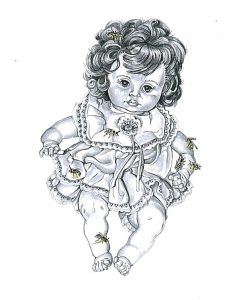
by Jennifer Sears
I sought out Barbie in SmokeLong Quarterly stories naively thinking I might end up with an assortment of lightly humorous observations that might speak to the “cultural moment” after the release of Greta Gerwig’s glossy blockbuster movie in July 2023. A quick search intrigued me even more. SmokeLong Quarterly Barbies span almost the breadth of the magazine’s publication. She appears first in an eerily prescient 2004 editor interview and most recently in K Ming Chang’s Vengeance, published in 2020.
However, as I read through the self-curated selection of flashes, the feeling that emerged was far from lighthearted. For one thing, Barbies that appear in SmokeLong Quarterly are most often… dolls. Barbie is simply there, a silent, pink-lipped witness, a thing to be loved, manipulated, or discarded by characters who experience hurt, pain, cynicism, bitterness, and shaken innocence in the rush of their uneasy lives. Unlike the movie, these Barbie stories take risks. They reflect the complicatedness of real Barbie relationships and experiences in real lives.
Barbie’s iconic label and presence creates fast familiarity for both flash fiction readers and filmgoers. Brand-specific references and characters are used to “pre-sell” a film. Producers of the Barbie movie—and the sponsoring companies, can count on a built-in audience and future consumers. (Think Star Trek remakes or superhero movies with their panoply of products.) The United States does this increasingly well. As one maker featured below, Brian Allen Carr, states in an interview: “America has basically outsourced everything but entertainment, and our society reflects this at all levels.” The entertainment industry has impacted how we read. What we watch. How we might “watch” books instead of reading them. How we learn or don’t learn how to interact with each other. How we learn to treat or mistreat ourselves.
Though brand names in fiction are used to evoke fast familiarity or understanding of character, these SmokeLong Quarterly Barbies have nothing to do with financial profit. As I read, I found Barbie and her many accoutrements, her “what’s in the box,” add detail and emotional impact to what the flash fiction form does so well–disturb, discomfort, stick–with no soundtrack other than our own discomfort.
Gerwig’s movie has received accolades for “reframing” gender discussions. However, the tensions displayed larger than life on screen seem like gaudy, candy-coated group therapy compared to what happens between males and females in these stories. Here, men appear, but not as black-suited Mattel executives conspiring around glossy tables, or Barbie makers on pink jet skis, or as an array of neutered Kens playing beach volleyball. In these stories, Kens are boyfriends and ex-husbands angered by betrayal. They are losers who become dangerous when broke, loners who need a tinge of violence to satiate their lust, men who make women into porn stars.
But mostly these are stories of young women and girls learning the rules and sadness required to play in our very real world, females learning what can happen when no one is looking. These Barbies are vulnerable. They are dressed and undressed. They are touched. They are forgotten and left to rot. They break rules, live with consequences, and learn how, like Barbies, one’s old self must sometimes be thrown away.
“I kind of wanted to protect these girls. . .,” says SmokeLong Quarterly Barbie maker Rebecca Podos, featured below, “. . . but that probably wouldn’t have been a story.”
What follows is fiction, Barbie stories doing the dark work the film version cannot do.

October 12, 2020
Maker: K Ming Chang
Young girls cut off their own nipples, turn Barbie’s hair blue, love the word revenge, they dream together of leaving this world, of becoming flies, even before they find with their feet that girl with her limbs curled, buried in the bottom of the creek.
What’s in the Box: pennies, teal eyeshadow, crushed pearl powder, a bruise, stones for swallowing.

June 17, 2019
Maker: Claudia Monpere
Those childhood secrets we try to run away from but come home still carrying, secrets dressed up like shame wearing tiny open toe heels.
What’s in the Box: Lululemon jogging pants, sheer pink baby doll dresses with blue ribbon straps, knitting needles, a white sheath dress accessorized with chiffon purse, white tricot gloves, a pearl necklace, and white open toe heels; a rose sleeveless dress accessorized with a white apron and chef’s hat; lemon-yellow bell bottoms with a wide white belt and striped shirt. A painting of birds flying kites shaped like people.
Ken says, “My God, Barbie, all this stuff.”
Still, Barbie is not allowed to speak.

April 24, 2017
Maker: Mami Pound
Ken, knowing does not and will never add up, finds a relationship in which he can call every shot. He dresses her, admiring his big fingers on her tiny zippers. Suspecting she’s a liberal, he forces her to watch Fox News, her legs open around the arm of the recliner. He twists her back and forth between his hands until her hair goes staticky and wild. “Nice girls don’t make the first move,” his mother says. He gives her a bath.
What’s in the Box: a sheer floral dress, her Barbie bubble bath, her tiny Barbie brush.
At night, Barbie sleeps on his own pillow, her silence a shadow grown large.

March 20, 2017
Maker: Chelsea Harris
She lives with her parents in hotels, doesn’t think twice about heading into another man’s room to satisfy his kink in exchange for an M&M Freezee but is too afraid to look at his eyes when she opens her tiny pink mouth to eat.
What’s in the Box: an electrocautery, a carry-on suitcase, a cooked goose with berry gravy, a circus that does not exist, and a mother’s warning: “Do not end up a Barbie Dreamhouse with a fire in your gut.”
Some dreams and dives burn for the rest of your life.

Sept. 5, 2016
Maker: Michele Finn Johnson
This Barbie wears a sunflower nightgown, weaves French braids in little girls’ hair, and whispers to them about her strange Ken: “…don’t tell anyone about…him.” Then she disappears.
On TV, helicopters search for lost soldiers in Viet Nam, the chopping sound mixing in with the chop over their heads, the neighborhood search for their missing sunflower girl.
The little girls keep their promise. They don’t tell anyone about her Ken.
What’s in the Box: two Burger King napkins, a diary, enough sticks and rotted leaves to cover Barbie’s tiny body, a Ouija board with a planchette hovering over Barbie’s “good-bye.”
Barbie, Patron Saint of Little Girls’ Secrets

Sept 24, 2013
Maker: Rebecca Podos
The little girls lay awake listening to yellowjackets imprisoned between walls–so many wings, so many devouring, hungry mouths all around them. The secret they won’t tell their father: which sister got too close to the Pest Man, how he picked her up with his big hands and pressed her body, half naked in her bikini, against his.
“All it takes is teeth and time,” The Pest Man tells their father.
Where is Barbie here? There she is on the chests of their little girl night gowns, like Medusa’s grinning face centered on Athena’s shield.

March 26, 2013
Maker: Tara Lynn Masih
What’s in the Box: GI Joes, corn on the cob, real Oscar Mayer hot dogs, dirty books that teach the young girls secrets during sleepovers, a toothbrush, another nightgown, a Matchbox car with a tiny steering wheel stolen for a brother who doesn’t even ask for it.
Did you know Barbie drives a Chevrolet? Did you ever ask yourself why?

June 16, 2008
Maker: Brian Allen Carr
Two young Kens, imagining their jobs and livelihoods taken by people in other countries, believe they’ve found something bold and original, when all they’re doing is the shit unimaginative people have done for ages. This Barbie flails in front of the camera’s red eye. For a moment there is hope one Ken will say stop, one Ken will say: here is pain.
What’s in the Box: chocolate covered pretzels, gnarled knees, a violin, wildflowers, fennel fronds, a bottle of Barbie dress-up perfume.
Did that perfume ever exist? Could you wear it now?

March 15, 2004
Maker: Terry Dehart
A writer in the “winter of his life” crawls through a hole in a fence. Will he or won’t he confront his character? Is that what we expect? Is that what writers do?
What’s in the Box: rejection slips, a padded cell. This maker states in an interview that “editing flash is like giving a nano-scale Barbie a pelvic exam,” presaging the ending of Gerwig’s Barbie film by almost two decades.
The SmokeLong Quarterly Barbie catalog ends here for now. Unlike Gerwig’s movie, the pelvic exam, the work of editing and tweaking and simply looking, is performed in full in each story. No panning out, no pink sugary laughter, no looking away from the ugliness or discomfort we don’t wish to see. No musical soundtrack to make it go down easier. More SmokeLong Barbie stories will likely be written. Whether we like her or not, she represents something in the US-American national and increasingly national psyche. SmokeLong Barbie is not going away.
__________________________
 Jennifer Sears has received fiction writing fellowships from the National Endowment for the Arts (NEA) and the New York Foundation for the Arts (NYFA). Her stories and essays have been published in The Kenyon Review, Electric Literature’s Recommended Reading Series, Witness Magazine, Guernica, Ninth Letter, Fence, The North American Review, Nabokov Studies Journal, and elsewhere, and have received citations in Best American Essays, Best American Short Stories, and Best American Non-Required Reading. She teaches creative writing and composition in the English Department at New York City College of Technology, City University of New York.
Jennifer Sears has received fiction writing fellowships from the National Endowment for the Arts (NEA) and the New York Foundation for the Arts (NYFA). Her stories and essays have been published in The Kenyon Review, Electric Literature’s Recommended Reading Series, Witness Magazine, Guernica, Ninth Letter, Fence, The North American Review, Nabokov Studies Journal, and elsewhere, and have received citations in Best American Essays, Best American Short Stories, and Best American Non-Required Reading. She teaches creative writing and composition in the English Department at New York City College of Technology, City University of New York.


 The core workshop of SmokeLong Fitness is all in writing, so you can take part from anywhere at anytime. We are excited about creating a supportive, consistent and structured environment for flash writers to work on their craft in a community. We are thrilled and proud to say that our workshop participants have won, placed, or been listed in every major flash competition. Community works.
The core workshop of SmokeLong Fitness is all in writing, so you can take part from anywhere at anytime. We are excited about creating a supportive, consistent and structured environment for flash writers to work on their craft in a community. We are thrilled and proud to say that our workshop participants have won, placed, or been listed in every major flash competition. Community works.